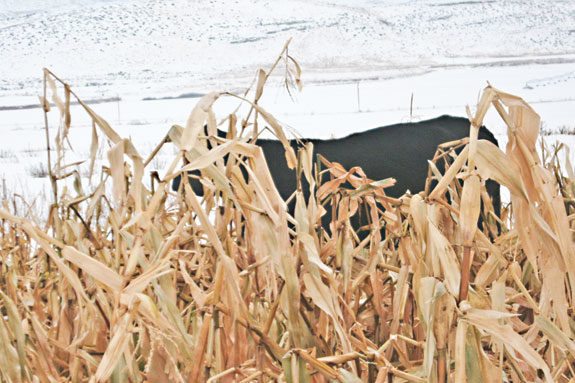BMR increases the value of the non-grain portion of the plant because it reduces lignin, which is indigestible to ruminant animals. In other words, not only do we have the highly digestible grain portion, but we have also increased the digestibility of the stalk and leaves.
The BMR gene is also found and is being utilized in sorghum, sorghum-sudan and pearl millet. Often when there is an improvement in something, it comes with a cost or trade-off; so it is with corn.
Lignin is the structural material in corn that keeps it standing until harvest. While extremely important in grain production, it is not as important in forage production because the crop is harvested before the stalk dries down.
BMR sorghum, sudans and pearl millet are very useful in hotter climates because they can get by on less moisture. They require a soil temperature of 60 degrees, while corn is planted when soil temperatures reach 50.
Sorghum-sudans and millets tiller profusely, allowing several harvests. Because these crops are lower-quality forage than corn and because of their tillering nature, they are often grazed. For this reason, there are many studies involving beef on sorghum or sorghum-sudan.
While there is much data on the advantages of BMR corn silage, there is virtually no data on grazing BMR corn. Studies in recent years have shown about a five-pound-per-day increase in milk production with BMR corn silage over normal corn silage. But, whether for grazing or silage, BMR has always shown superiority in quality, both in milk production and weight gain.
Recent standability improvement and harvesting techniques of BMR corn have allowed better seed production and lower-priced seed. Because corn does not tiller, it allows for only a single harvest. As a single-harvest crop after a cool-season annual forage or grain crop, however, it cannot be beat. Because of the larger seed, it starts out faster and will produce more high-quality forage in a shorter period than sorghum or millet.
There is more land in pasture than crop land in the U.S. Some of this land is too rough or dry for cultivated crops. Many of these pastures have small areas of rich soils too small to farm but which could be worked and planted with a cereal crop, followed by a grazing corn and then harvested by cattle.
In most areas, it is difficult for the economics of annual grazing to pencil out on land that can grow grain crops when grain prices are high. The possibilities, however, for BMR corn as a second crop are almost endless.
It could be planted after a cool-season grazing crop, a cool-season cereal crop, first- or second-cut alfalfa, peas or other early vegetable crop. It can also be planted after peas, cool-season grazing crops or as late as after second-cut alfalfa or even winter wheat.
An interesting possibility with circle irrigation and a sufficiently long season would be to plant BMR corn into small grain stubble. During the hottest part of the year, when a crop would be using the greatest amount of moisture, the crop is maturing. BMR seeded into grain stubble allows the stubble to conserve moisture until the corn shades the ground. Irrigation guarantees moisture for quick germination and growth.
You could graze stockers or even grass-fatten cattle. Or since beef cows do not require high-quality feed, the BMR could be allowed to go to tassel or beyond for maximum tonnage and still be high-quality beef cow feed.
This gives the rancher many options. Some producers have become used to harvesting and hauling feed to the animal, but it is much cheaper in machinery, fuel and labor to have the animal do the harvesting. Farmers who have used rotational grazing report less labor used in moving the hot wire than when harvesting the forage.
Another thing going for grazing is that stored forages drop in quality when harvested. Forage cut for hay immediately begins losing the most digestible, soluble portion through respiration. Minimum losses are usually close to 20 percent and, with leaf and storage losses, can approach 40 percent to 50 percent.
However, ranchers might choose to harvest part of the crop with hay equipment and put it up as silage, baleage or even hay. Cutting corn prior to tassel is relatively a new idea in the Northwest.
This will be profitable in a double-crop scenario with reasonable seed cost. It could replace followup crops like sudan sorghum if there is only enough growing season for one cutting. Corn will be higher-quality and produce more tonnage in a shorter amount of time. Corn is just a sub-tropical grass. So, like all grass, it will be the best quality when cut prior to tassel, although not the best tonnage.
One thing that will surprise most people is that a short- day corn planted in the middle of the summer will grow very fast and get just as tall as the same corn planted in the spring. This is due to the higher heat units while the corn is in the early stage. When ears will begin to develop depends on the fall weather, but most likely they will not dent down and finish properly.
Over 95 percent of milk cows are in areas where an early-maturity BMR corn can be taken off in time to fall-establish alfalfa or to fall-seed other crops. An early BMR corn could also be planted later after first-cut alfalfa or after a grazing crop and still reach black layer for silage.
Not so many years ago, most milk and beef was produced on grass. With cheap fuel and better machinery, farmers moved to stored feed, but perhaps BMR will bring more grazing practices back to the ruminant animal. FG
Chris Ray is a partner at Ray Brothers Seed in Caldwell, Idaho. He can be reached at chrisray@raybrothers.net









